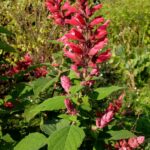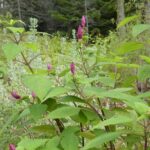Salvia ‘Raspberry Surprise’; is a medium to tall dense bushy shrub 2-3mH with large spires of watermelon pink flowers in winter through to early summer.
Salvia ‘Raspberry Surprise ‘ is actually a Salvia karwinskii hybrid.
Flowers: are a watermelon pink, tubular with a small hood and lobes.The hood is covered with tiny pink hairs, with the bottom lobe being bent down to open up the throat, allowing the beaks of the little Eastern Spinebill to penetrate down the tube to find the nectar. The bottom lobe is a very pale pink or white, which acts as a beeline to guide any insects and birds into the throat. The 2 side lobes are very small but are tucked into the side of the bottom lobe.
The flower heads are in whorls of 4-8 flowers either side of the stem, approx 20 whorls, are densely packed into that flower head. Like most S.karwinskii varieties, some flowers are open, while others are still in bud, waiting to open. This method of flowering allows the plant to flower over a long period of time
Flower heads are at the end of the stems well clear of the foliage to attract any passing birds or insects.
Calyces: are a pinkish/ brown colour , covered in pink hairs along the ribs. Lobes are very pointed, to be able to hold such a long tube.
These fall off if the flowers are not pollinated, leaving a bare stem.
Leaves: are a lovely mid green colour, lanceolate with a hairy texture of fine hairs on top and soft white hairs beneath. Veins are well indented allowing any moisture to either run off the tip towards the roots or run back down the petiole towards the base of the plant.
Each stem is well clothed with leaves which have a pleasant salvia fragrance.
Salvia ‘Raspberry Surprise’ forms a good dense bushy plant, which is proving to be tough and hardy for the summer heat, the winter cold and tolerating a mild frost.
Grow in full sun to keep it bushy, either as a screening plant or with other similar sized shrubs as a background to small brightly coloured shrubs and perennials. It will form a neat tight clump of stems with good growth all year.
Maintenance: as this shrub is lovely and bushy, it doesn’t produce those bare stems that many other varieties show. This denseness helps to keep it’s natural shape. Most of the other varieties need an annual prune of older stems, this shrub can be left for a couple of years without cutting down or pruning. In summer there may be the need to just trim to shape with the occasional need to remove an old stem.
Propagation: usually tip cuttings, taken at any time of year, but cuttings of new growth are preferred, which will have thicker stems. These should strike easily. See the propagation page for more information.



